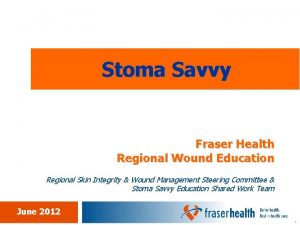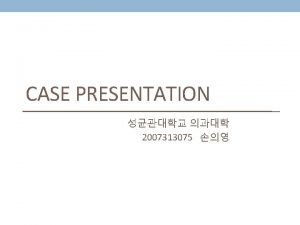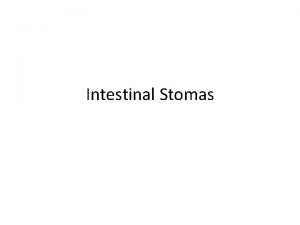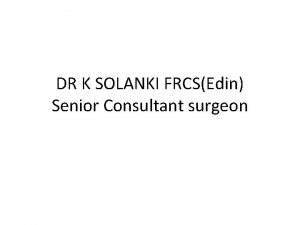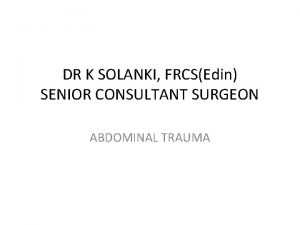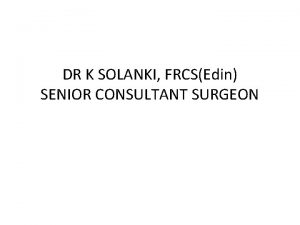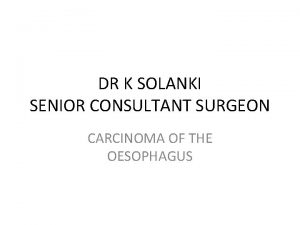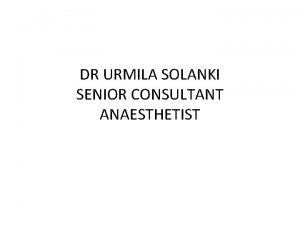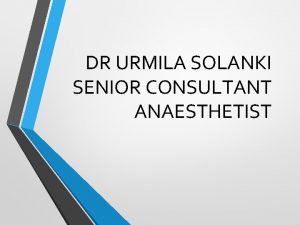DR K SOLANKI FRCSEdin Senior Consultant surgeon COLOSTOMY











- Slides: 11

DR K SOLANKI FRCS(Edin) Senior Consultant surgeon COLOSTOMY

• Artificial opening made in the large bowel to divert faeces and flatus to the exterior, where it can be collected in an external appliance. • Temporary or permanent.

TEMPORARY COLOSTOMY • In the past, most commonly used to defunction an anastomosis after an anterior resection. • Now a loop ileostomy is preferred. • A loop left iliac fossa colostomy is still sometimes used to prevent faecal peritonitis developing following traumatic injury to rectum, to facilitate the operative treatment of high fistula-in-ano and incontinence.

• A temporary loop colostomy is made, bringing a lop of colon to the surface, where it is held in place by a plastic bridge passed through the mesenetry. Once the abdomen is closed, the colostomy is opened, and the edges of the colonic incision are sutured to the adjacent skin margin. The bridge removed after 7 days when firm adhesions of the colostomy to the abdominal wall has taken place.

• The colostomy can be closed following the surgical cure or healing of distal lesion. • Colostomy closure is most easily and safely accomplished if stoma is mature, i. e. after two months.

• Double-barrelled colostomy • Rarely used now, occasionally thre colon is divided so that both ends can be brought to the surface separately, ensuring that the distal segment is completely defunctioned.

PERMANENT COLOSTOMY • Usually after excision of the rectum for a carcinoma by abdomino-peritoneal technique. • It is formed by bringing the distal end (endcolostomy) of the divided colon to the surface in the left iliac fossa, where it is sutured in place, joining the colonic margin to the surrounding skin.

COMPLECATIONS OF COLOSTOMY 1. Prolapse 2. retraction 3. necrosis of the distal end 4. fistula formation 5. stenosis of the orifice 6. colostomy hernia 7. bleeding (from granulomas around the margins of colostomy) • 8. colostomy ‘diarrhoea’: is usually an infective enteritis – will respond to oral metronidazole 200 mg TDS. • •

• Loop ileostomy: • Now often used as an alternative to colostomy, particularly dor defunctioning a low rectal anastomosis. • The advantages over a loop colostomy are the ease with which the bowel can be brought to the surface and the absence of odour.

• Caecostomy: • Rarely used now. • In very ill patients with advanced obstruction, a caecostomy is useful. In late cases of obstruction, the caecum may become so distended and ischaemic that rupture of the caecal wall may be anticipated. This can occur spontaneously causing faecal peritonitis, or at operation, when an incision in the abdominal wall reduces its supportive role and allows caecum to expand.

• In such a situation, it should be decompressed by suction as soon as the abdomen is opened. • In thin patients, it may then be possible to carry out direct suture of the incised or perforated caecal wall to the abdominal skin of the right iliac fossa. • Following on table lavage, via the appendix stump, the irrigating catheter can be left in place as a tube caecostomy. • Caecostomy is only a short-term measure. Reoperation should follow as soon as patient improves, and a definitive procedure should be carried out.




